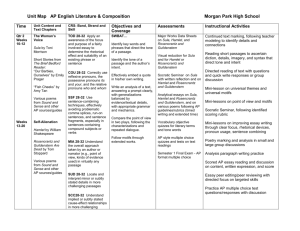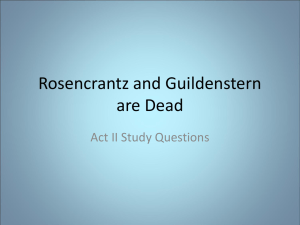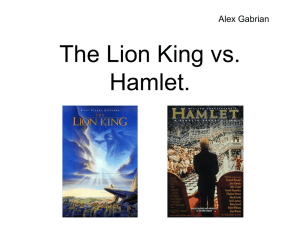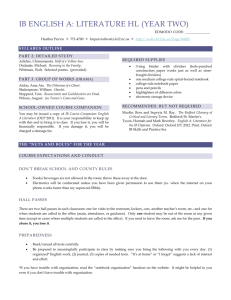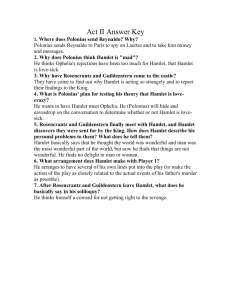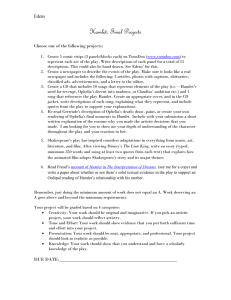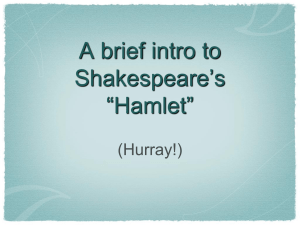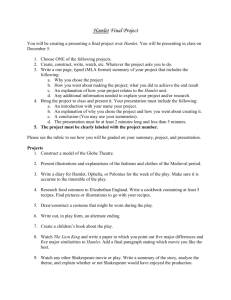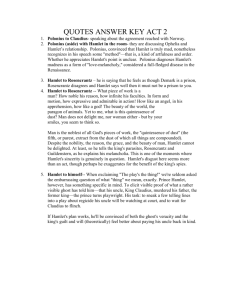Strange Brew & Hamlet: Rosencrantz & Guildenstern Analysis
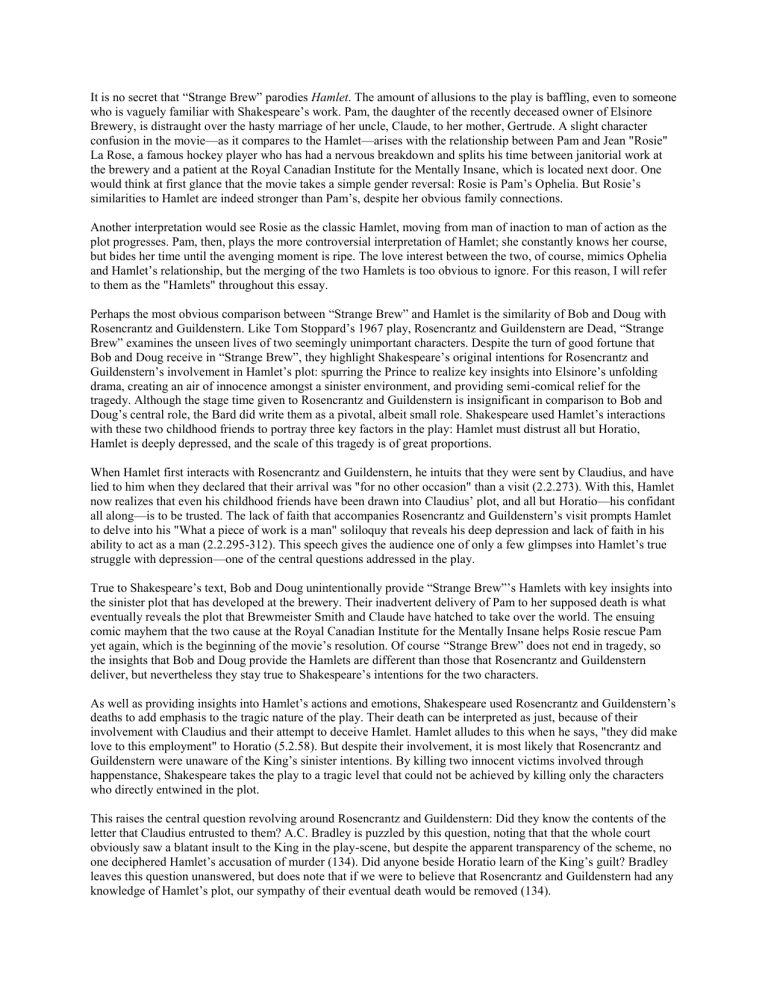
It is no secret that “Strange Brew” parodies Hamlet . The amount of allusions to the play is baffling, even to someone who is vaguely familiar with Shakespeare’s work. Pam, the daughter of the recently deceased owner of Elsinore
Brewery, is distraught over the hasty marriage of her uncle, Claude, to her mother, Gertrude. A slight character confusion in the movie—as it compares to the Hamlet—arises with the relationship between Pam and Jean "Rosie"
La Rose, a famous hockey player who has had a nervous breakdown and splits his time between janitorial work at the brewery and a patient at the Royal Canadian Institute for the Mentally Insane, which is located next door. One would think at first glance that the movie takes a simple gender reversal: Rosie is Pam’s Ophelia. But Rosie’s similarities to Hamlet are indeed stronger than Pam’s, despite her obvious family connections.
Another interpretation would see Rosie as the classic Hamlet, moving from man of inaction to man of action as the plot progresses. Pam, then, plays the more controversial interpretation of Hamlet; she constantly knows her course, but bides her time until the avenging moment is ripe. The love interest between the two, of course, mimics Ophelia and Hamlet’s relationship, but the merging of the two Hamlets is too obvious to ignore. For this reason, I will refer to them as the "Hamlets" throughout this essay.
Perhaps the most obvious comparison between “Strange Brew” and Hamlet is the similarity of Bob and Doug with
Rosencrantz and Guildenstern. Like Tom Stoppard’s 1967 play, Rosencrantz and Guildenstern are Dead, “Strange
Brew” examines the unseen lives of two seemingly unimportant characters. Despite the turn of good fortune that
Bob and Doug receive in “Strange Brew”, they highlight Shakespeare’s original intentions for Rosencrantz and
Guildenstern’s involvement in Hamlet’s plot: spurring the Prince to realize key insights into Elsinore’s unfolding drama, creating an air of innocence amongst a sinister environment, and providing semi-comical relief for the tragedy. Although the stage time given to Rosencrantz and Guildenstern is insignificant in comparison to Bob and
Doug’s central role, the Bard did write them as a pivotal, albeit small role. Shakespeare used Hamlet’s interactions with these two childhood friends to portray three key factors in the play: Hamlet must distrust all but Horatio,
Hamlet is deeply depressed, and the scale of this tragedy is of great proportions.
When Hamlet first interacts with Rosencrantz and Guildenstern, he intuits that they were sent by Claudius, and have lied to him when they declared that their arrival was "for no other occasion" than a visit (2.2.273). With this, Hamlet now realizes that even his childhood friends have been drawn into Claudius’ plot, and all but Horatio—his confidant all along—is to be trusted. The lack of faith that accompanies Rosencrantz and Guildenstern’s visit prompts Hamlet to delve into his "What a piece of work is a man" soliloquy that reveals his deep depression and lack of faith in his ability to act as a man (2.2.295-312). This speech gives the audience one of only a few glimpses into Hamlet’s true struggle with depression—one of the central questions addressed in the play.
True to Shakespeare’s text, Bob and Doug unintentionally provide “Strange Brew”’s Hamlets with key insights into the sinister plot that has developed at the brewery. Their inadvertent delivery of Pam to her supposed death is what eventually reveals the plot that Brewmeister Smith and Claude have hatched to take over the world. The ensuing comic mayhem that the two cause at the Royal Canadian Institute for the Mentally Insane helps Rosie rescue Pam yet again, which is the beginning of the movie’s resolution. Of course “Strange Brew” does not end in tragedy, so the insights that Bob and Doug provide the Hamlets are different than those that Rosencrantz and Guildenstern deliver, but nevertheless they stay true to Shakespeare’s intentions for the two characters.
As well as providing insights into Hamlet’s actions and emotions, Shakespeare used Rosencrantz and Guildenstern’s deaths to add emphasis to the tragic nature of the play. Their death can be interpreted as just, because of their involvement with Claudius and their attempt to deceive Hamlet. Hamlet alludes to this when he says, "they did make love to this employment" to Horatio (5.2.58). But despite their involvement, it is most likely that Rosencrantz and
Guildenstern were unaware of the King’s sinister intentions. By killing two innocent victims involved through happenstance, Shakespeare takes the play to a tragic level that could not be achieved by killing only the characters who directly entwined in the plot.
This raises the central question revolving around Rosencrantz and Guildenstern: Did they know the contents of the letter that Claudius entrusted to them? A.C. Bradley is puzzled by this question, noting that that the whole court obviously saw a blatant insult to the King in the play-scene, but despite the apparent transparency of the scheme, no one deciphered Hamlet’s accusation of murder (134). Did anyone beside Horatio learn of the King’s guilt? Bradley leaves this question unanswered, but does note that if we were to believe that Rosencrantz and Guildenstern had any knowledge of Hamlet’s plot, our sympathy of their eventual death would be removed (134).
Although the question of Rosencrantz and Guildenstern’s innocence is debatable, I agree with Charles Boyce’s interpretation, that they were "innocent victims of Hamlet’s counterstroke" (566). Boyce and Gary Crowdus refer to them as "toadies" (566; 16), and some critics go so far as to call them "the Tweedledee and Tweedledum" of Hamlet
(Rhu 324). Bradley’s confusion is justified for other, more intellectually astute members of the court, but as
“Strange Brew”’s portrayal of these characters emphasizes, Rosencrantz and Guildenstern were most likely simpletons, with no real ambitions except to please those in charge.
The illumination of Rosencrantz and Guildenstern as naively ignorant characters is constantly reinforced throughout
“Strange Brew”; indeed, the comic idiocy of Bob and Doug is inarguably the central theme of the movie.
Paradoxically, Bob and Doug’s simple-minded thinking and innocent curiosity are what lead to the various hairbrained resolutions that eventually save the day. Doug’s idea to have Bob pee-out the fire that threatens to burn down the insane asylum, their childish curiosity with technology that unveils the ghost, and later the floppy disk that contains the crucial incriminating evidence against Brewmeister Smith are only a few of the many examples of their naïveté paving a path to resolution. Bob and Doug’s innocence eventually leave us with the death of Brewmeister
Smith—the only truly evil character—and a resolved plot, all the while delighting us with laughter.
Comedy was likely one of Shakespeare’s motives in creating Rosencrantz and Guildenstern. The mere pronunciation of their names provides Hamlet with a "faintly comical tone" (Boyce 566), which Shakespeare must have played on intentionally. These two characters have become so enmeshed together that one is rarely referred to without the other (Boyce 566). In some editions of Hamlet, Rosencrantz briefly appears alone, but only long enough to deliver five lines to King Claudius before Guildenstern arrives (4.3.11-16), and then exits a few lines before Guildenstern when he is commanded by Claudius to find Polonius. Although this separation of the two characters follows the
First Folio text, editors often omit it (Boyce 566). The constant appearance of Rosencrantz and Guildenstern together highlights the semi-comical nature that they were undoubtedly used to convey.
The interchangeable nature of Rosencrantz and Guildenstern is highlighted throughout “Strange Brew”, by poking fun at Bob and Doug’s brotherly dependence on one another. Despite their constant bickering, wrestling, and insulting, Bob and Doug are inseparable. This is made clear in a wonderfully witty scene, when it comes time for the two to briefly part ways. Pam, comforting a blubbering Bob asks, "You mean you’ve never been apart?" Between his sobs and sniffles, Bob replies, "No, not never." Despite the blatant parody on Rosencrantz and Guildenstern’s inseparability, this scene does with Bob and Doug exactly what Shakespeare intended of his duet: to provide comic relief with their almost constant togetherness onstage.
Joseph Hynes argues that Stoppard’s Rosencrantz and Guildenstern are Dead reveals an existential view of "the familiar issue of determinism vs. free-will" (644). Using this analysis, we might think of “Strange Brew” as revealing the familiar perspectives of Donald Duck vs. Free Willy. It is by no means a serious movie—Bob and
Doug are bumbling idiots whose only motivation is to please their parents, eat donuts, and drink beer—and the soothing and comedic resolution that “Strange Brew” offers is far from the bitter tragedy that ends Hamlet. But, like
Stoppard’s masterpiece, “Strange Brew” accurately portrays—and even highlights—the importance of Rosencrantz and Guildenstern’s interactions with the Prince of Denmark as a key catalyst in the tragic plot.
Downloaded from the internet
